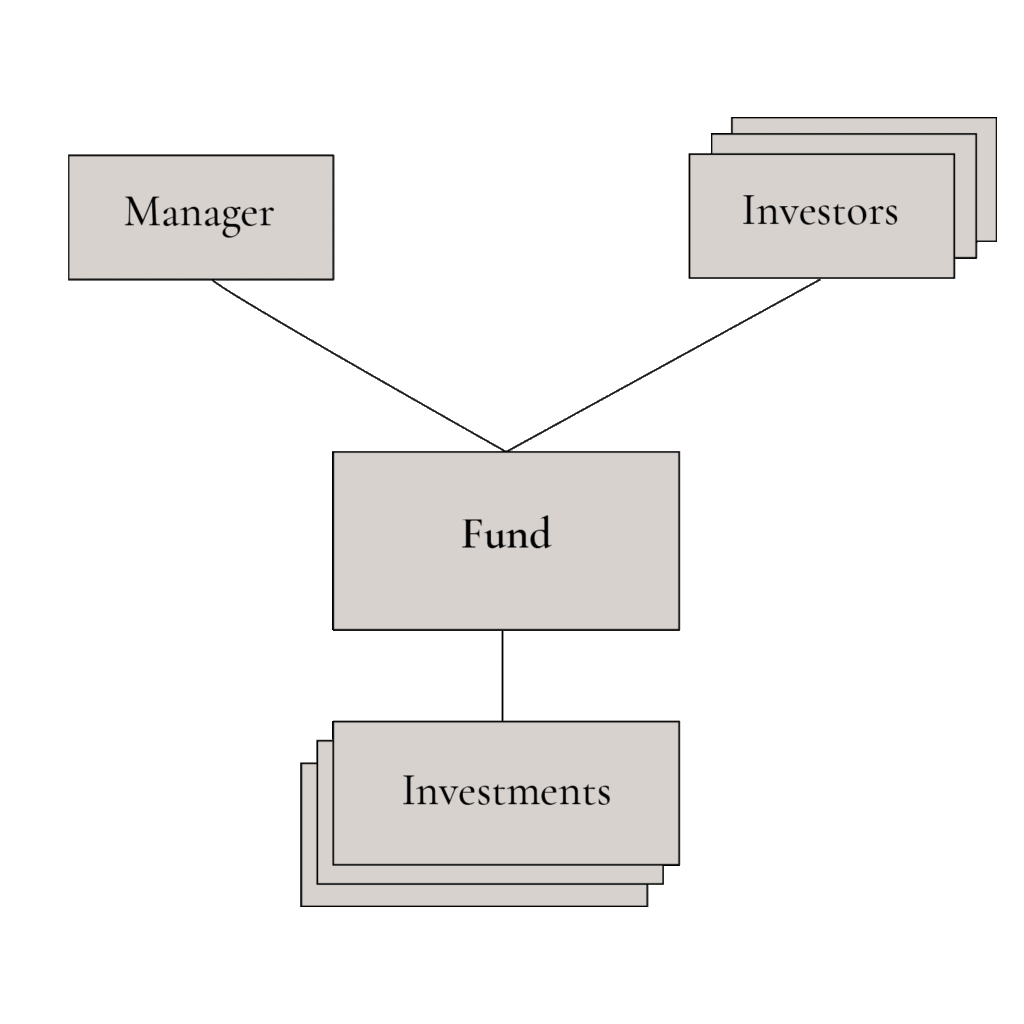
Expanding your capital raise to Luxembourg
Expanding your capital raise to Luxembourg Luxembourg’s position as a key jurisdiction for alternative funds offers a compelling path for Nordic managers who wish to

The Private Equity industry is awash with lingo & to navigate the landscape we have summarized some key terms and concepts which are common among market participants in Sweden and abroad.
In a private equity fund, the advisory board plays a crucial role in providing oversight of the management team. This typically includes advising on how Conflicts of Interest should be handled, reviewing deviations from the investment strategy, as well as reviewing policies, guidelines, and performance of the fund. Other duties which may befall on the Advisory Board include strategic guidance, performance monitoring, valuation oversight, risk management advisory, and general governance and compliance.
The Alternative Investment Fund Managers Directive (AIFMD) is a European Union directive that regulates the activities of alternative investment fund managers (AIFMs). It was established to create a comprehensive regulatory and supervisory framework for AIFMs within the EU. The directive applies to managers who manage and/or market alternative investment funds (AIFs) in Europe, and it requires them to become authorized by their local regulator as an AIFM unless an exemption applies.
Carried interest is designed to align the interests of fund managers with those of investors by tying the manager’s compensation to the fund’s performance. This is done by allocating the manager a share of the profits as an incentive and is usually structured as a partnership or company allocation of profits rather than as a fee. In a typical private equity fund the general partner receives a carried interest equal to a specified percentage (often 20%) of the cumulative net profits from the fund’s investment program. Unlike management fees, carried interest is generally only received when cash is distributed from the fund, typically after investments are sold.
It is not uncommon for a fund to encounter an investment opportunity in a portfolio company that surpasses the funds investment capacity or interest to invest. In such event the Manager may extend an invitation to investors or third parties to co-invest alongside the fund. These types of investments can be very attractive to Investors as many times co-investments are structured with more favourable Management Fees and Carried Interest, or without any Carried Interest at all.
The investor’s funding obligations are limited to their Commitments, which are subject to Capital Calls, or Draw Downs. Amounts so paid in to the Fund are referred to as Contributions, or amounts “Drawn Down”. This is important terminology as the phrasing and use in both the Waterfall and rest of the Fund agreement may impact how returns and carried-interest splits are calculated.
This is part of the funds Investment Policy and relates to how investments are spread, or diversified, such as geographically, via market sectors, etc.
Oh the joy of agreements!
The Term Sheet is a shorter, often standardized document aimed at crystallizing the legal terms of the fund. This is often no more than 3-7 pages long and is likely the first legal document for the fund the investors will read so albeit short in form the devil is in the details.
An LPA is a limited partnership agreement and is sometimes casually used for fund agreements in Sweden although almost always what is actually referred to is an Investment and Shareholders’ Agreement, the ISA. This is the core of the fund legal package and covers all aspects relating to the investors, management team, Key Persons and how the money flows in and out of the structure. Often times lead investors representing a significant Commitment will contract individual legal teams to review and comment on the ISA and negotiations on terms can be extensive if the document is poorly drafted or is deemed “off market”.
The Subscription Application, SA, or Subscription/Signature Documents are what the investors sign to commit to the fund and often include investor classification & KYC documents.
In addition to the above ancillary documentation regarding environmental aspects, Key Information Document (KID) etc. which will be part of the final package of documents provided to investors and, as applicable, regulators.
Many investors require terms which stipulate that the fund will not hold its first closing unless total Commitments equal or exceed a specified amount. This establishes a financial threshold for the fund’s viability and operational commencement. The total Commitments the Manager is allowed to raise in any one fund is generally referred to as a Hard-Cap. A cap on total funds aligns the fund’s investment strategy with the size of the team. A smaller team establishing a first time fund in Sweden will often seek at least SEK 300-500 million in Commitments but this varies greatly depending on how the team seeks to deploy the capital and their composition, experience and reputation.
Investors are typically removed from all investment decisions in the fund and only Key Executives or independent persons appointed by them will participate in investment decisions and the governance of the fund. This ensures that investment decisions are made without undue influence from investors, maintaining the fund’s strategic integrity. Investor participation is therefore often limited to the Advisory Board overseeing the activities of the Manager and advising on Conflicts of Interest.
A Fund will be marketed based on an investment philosophy, or investment policy. This can be a very diverse set of parameters ranging from investing in start-ups or growth companies to government contracts or art collections. There are few limits from a regulatory perspective regarding investment policies for funds geared at professional investors but most investors will seek to realize very clear investment restrictions which codify clear benchmarks in line with the investor’s capital deployment philosophy. This may include diversification limits such as no more than 15% of Commitments invested in any one company, geographic restrictions, or limits in the amount of capital deployed in certain sectors. Many investors also deploy strict ESG standards. An example can be found from at the European Investment Fund and as is evident there are a number of sectors which may prohibit fundraising from certain institutional investors if the investment policy is carelessly crafted.
The Investment Period refers to a specific timeframe during which the Fund actively seeks and makes new investments and typically lasts for a set number of years from the Fund’s initial closing date, often around 3 to 5 years, but it can vary depending on the fund’s strategy and terms.
In Sweden funds will often be structured as a Swedish limited company (Sw. aktiebolag) which is a legal entity where the shareholders’ liability is limited to their share capital save for in special circumstances. The company usually has two or more share classes, one share class entitles to Carried Interest, other classes being investor shares entitling to return on capital, Preferred Return and profits less Carried Interest. Often the manager is a separate company, but not always. Outside of Sweden it’s common to use a limited partnership structure, which in Sweden is called a kommanditbolag.

The investors of a fund are often referred to as “LPs” which comes from the Anglo-Saxon term limited partner, being the investor in a limited partnership, a legal form which dominates the fund market internationally. The Manager, or “GP” controls the fund and plays a central and multifaceted role in the operation and management of the fund covering financial management, investor relations, governance, compliance, and strategic impact, ensuring the effective operation and management of the Fund. The Manager is led by the Key Persons, or Key Executives, and their employed management team. Often when setting out the initial team is comprised of just 2-4 Key Persons which operate the fund along with advisors and third party service providers. The Key Persons’ involvement is crucial for the fund’s success, and their departure can trigger a key person event, affecting Fund operations or even leading to liquidation of the Fund. As the team establishes successor funds the team has often grown by several people, perhaps even new Key Persons, and old-vintage international funds may have hundreds of employees in their management group.
The Manager’s operations are financed by a Management Fee, or Operational Cost, and are often calculated as a percentage of Commitments during the investment period and thereafter on the acquisition cost of unrealized investments. These fees compensate the Manager for their services and cover the fund’s operational expenses but are not intended to provide a financial incentive to the Manager. Management Fees vary depending on the type of Fund but are often 1.75% -2.5% per annum, reducing over time as the Fund’s Investment Period terminates.
The hurdle, or preferred return, is typically structured as a specified rate of return on amounts Drawn Down and that must be achieved before the general partner is entitled to receive Carried Interest. An industry standard is 6-8% per annum, compounded annually, although it can vary depending on the fund. In real-estate structures and certain other ventures the hurdle may also be calculated as an internal rate of return (IRR), which means the timing of realizations will impact total returns for the limited partners. It has also become more common for funds to not have a percentage hurdle at all and instead stipulate a multiple of commitments or amounts invested as the hurdle amount.
The regulatory framework governing private equity Funds serves to protect investors and limit systemic risks. Therefore the Funds are almost always limited to professional investors and will most likely be structured as an alternative investment fund as defined by the Swedish act implementing the AIFMD. Absent an exception this requires registration with the Swedish Financial Supervisory Authority (Sw. Finansinspektionen) for smaller funds, and full authorization for larger funds. Registration is a straightforward filing costing about SEK 30,000 often completed quickly by your legal team. There are also exceptions to the applicability of the AIFM-Directive as implemented in Sweden and certain real-estate, holding companies as well as investment companies may fall under such exemption but this often requires careful legal review. Smaller funds are typically not eligible to market interests to retail investors as they are afforded significantly more stringent regulatory protections including redemption rights and full authorization from the Swedish Financial Supervisory Authority.
Proceeds are distributed to investors and the Manager in a specified order with priority return to investors. The Waterfall section of the fund agreement determines how profits are shared, impacting investor returns and Manager incentives. European-style waterfalls calculate the distributions based on all investments in the Fund, while US-style waterfalls calculate distributions based on a deal by deal basis. The Waterfall typically includes the following steps:
First proceeds are used to repay investors for their Contributions.
Next, investors receive their Preferred Return, or Hurdle. Hurdle can be calculated in a myriad of ways and counsel will assist in choosing which options are best for your team based on investment policy & market trends.
A third step, called a “Catch-Up”, is often included and affords the Manager 20% of the Preferred Return (based on the principle the Manager is entitled to 20% of the profits).
Finally, 80% is allocated to the investors and 20% to the Manager. Certain funds also have additional steps or variations with “super-carry” upon overperformance, all aimed at creating the right mix of components to incentivize the Manager to create the desired returns.
The investors may wish to remove the Manager without the Manager having committed a serios breach of the fund agreement. This is referred to as no-fault removal and often requires the approval of at least 2/3 of the investors. Often no-fault removal grants the Manager a right to the financial benefit of actions taken up until the point of removal and sometimes thereafter why no-fault removal is deemed expensive for the Fund and, ultimately, investors. In the event the Manager or a Key Person has failed to fulfil their duties to the fund or is in material breach a “Cause” event may be at hand. In such event the investors, by a smaller majority, may elect to remove the Manager with prejudice and in such situations the Manager is typically sanctioned financially. The combination of no-fault divorce and for-cause removal provides mechanisms for investor protection and accountability in fund management while ensuring the Manager is protected from an unfair removal.
Understanding the terms and conditions of private equity funds is essential for both investors and fund managers. These terms will help guide your investment decisions, structure your agreements, and protect your interests.
At Oak One, we help our clients navigate these complex structures, ensuring that their investments are secure, their interests protected, and their long-term success achieved. If you’re considering investing in a fund or need advice on fund management, our expert legal counsel is here to guide you every step of the way.
Oh the joy of agreements!
The Term Sheet is a shorter, often standardized document aimed at crystallizing the legal terms of the fund. This is often no more than 3-7 pages long and is likely the first legal document for the fund the investors will read so albeit short in form the devil is in the details.
An LPA is a limited partnership agreement and is sometimes casually used for fund agreements in Sweden although almost always what is actually referred to is an Investment and Shareholders’ Agreement, the ISA. This is the core of the fund legal package and covers all aspects relating to the investors, management team, Key Persons and how the money flows in and out of the structure. Often times lead investors representing a significant Commitment will contract individual legal teams to review and comment on the ISA and negotiations on terms can be extensive if the document is poorly drafted or is deemed “off market”.
The Subscription Application, SA, or Subscription/Signature Documents are what the investors sign to commit to the fund.
The investors make binding commitments to finance the operations and investment activities of the Fund. Their respective funding amount is referred to as their Commitment.
A Fund will be marketed based on an investment philosophy, or investment policy. This can be a very diverse set of parameters ranging from investing in start-ups or growth companies to government contracts and art collections. There are few limits from a regulatory perspective regarding investment policies but institutional investors will seek to realize very clear investment restrictions which codify clear benchmarks in line with the investor’s capital deployment philosophy. This may include diversification limits such as no more than 15% of Commitments invested in any one company, geographic restrictions, or limits in the amount of capital deployed in certain sectors. Many investors also deploy strict ESG standards. An example can be found from at the European Investment Fund and as is evident there are a number of sectors which may prohibit fundraising from certain institutional investors if the investment policy is carelessly crafted.
The investors may wish to remove the Manager without the Manager having committed a serios breach of the fund agreement. This is referred to as no-fault removal and often requires the approval of at least 2/3 of the investors. Often no-fault removal grants the Manager a right to the financial benefit of actions taken up until the point of removal and sometimes thereafter why no-fault removal is deemed expensive for the Fund and, ultimately, investors. In the event the Manager or a Key Person has failed to fulfil their duties to the fund or is in material breach a “Cause” event may be at hand. In such event the investors, by a smaller majority, may elect to remove the Manager with prejudice and in such situations the Manager is typically sanctioned financially. The combination of no-fault divorce and for-cause removal provides mechanisms for investor protection and accountability in fund management while ensuring the Manager is protected from an unfair removal.

Expanding your capital raise to Luxembourg Luxembourg’s position as a key jurisdiction for alternative funds offers a compelling path for Nordic managers who wish to

Is your investment company an AIF? New regulations in 2025 could make non-compliance a criminal offense. Understand the key rules, exceptions, and what you need to do—before it’s too late!

We have gathered some of the most common questions we are asked during the initial stages of establishing a new fund.
Oak One is a boutique law firm specializing in tailored counsel to private equity funds, institutional investors, family offices & founders.